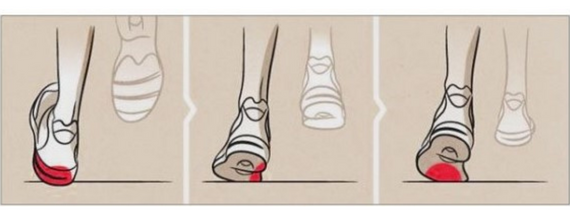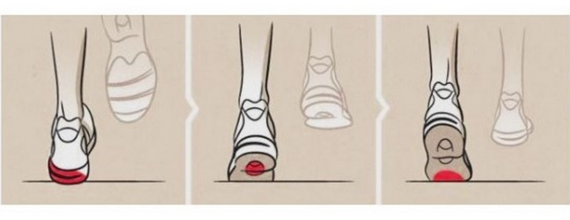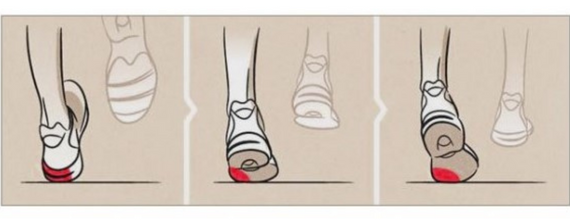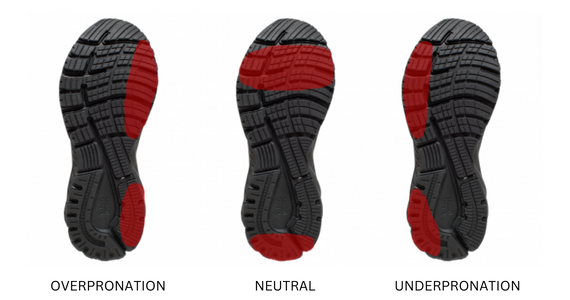If you're a runner, chances are you've heard of pronation and know that it's important to choose running shoes that accommodates your foot type. But what exactly is pronation, and how do you know if you have it? This guide will help you understand everything you need to know about pronation so that you can purchase the right running shoe.
What is pronation?
Pronation is a natural movement of the foot that occurs when we walk or run. It refers to the way the foot rolls inward and flattens out to provide shock absorption for the body. There are three types of pronation: overpronation, neutral pronation, and underpronation.
Overpronation

Overpronation occurs when the foot rolls inward too much, causing the ankle to collapse and putting extra stress on the knees and hips. The foot lands on the outside of the heel then rolls inward too much resulting in weight transferring to the inside of the foot. Overpronators “toe-off” using their big toe and second toe. They tend to have flat feet or low arches.
Common injuries for runners who overpronate are heel spurs, plantar fasciitis, shin splints and bunions. Injuries to the ankle, knee, and hip can also occur. People who overpronate often have to buy special shoes to help support their feet and prevent injuries.
Neutral

Neutral pronation is a term used to describe the natural movement of the foot. The foot lands on the outside of the heel, then rolls inward to absorb shock and support the body’s weight. Neutral runners “toe-off” evenly from the front of the foot. They tend to have normal-sized arches.
Neutral pronation is considered ideal because it provides the right amount of shock absorption and stability without putting unnecessary stress on the joint. While neutral runners are less likely to suffer from running related injuries, they are not immune to them.
Underpronation

Underpronation, also called supination, occurs when the foot doesn’t roll inward enough causing a great amount of shock to move through the lower leg. The outer side of the heel hits the ground and has little to no roll inward. Underpronators “toe off” with the smaller toes on the outside of their foot. They tend to have high arches.
Common injuries for runners who underpronate are shin splints, ankle sprains, Achilles tendonitis and plantar fasciitis. This can also lead to Injuries or pain in the knees, hips, lower back or other joints. People who underpronate need to ensure they wear shoes that provide enough support to absorb the shock. Orthotics and special shoe inserts can also help.
How to determine your pronation type?
There are several ways that you can determine your pronation type. One way is to look at the wear pattern on your shoes. If you notice that the wear pattern is more pronounced on the inside of your shoes, then you likely overpronate. If the wear pattern is more pronounced on the outside of your shoes, then you likely underpronate.

Another way to determine your pronation type is to ask someone to look at how your feet land when you walk or run. If your feet tend to roll inward when they hit the ground, then you probably overpronate. If they tend to roll outward, then you probably underpronate.
Finally, you can ask a professional to measure the angles of your feet and ankles to see which type of pronation you have.
What to look for in shoes?
Overpronation
When looking for shoes, it is important to consider what type of support the shoes will offer. If you overpronate, you need either motion control running shoes or stability shoes. This type of shoe has a firm heel counter that helps prevent your foot from rolling inward too much.
There are many different types of motion control shoes or stability running shoes available that offer different levels of support, so it is important to try on a few different pairs to see what works best for you.
Look for a running shoe with good arch support and a cushioned sole. Avoid shoes with a lot of wear on the inside edge of the heel; this can be a sign that the shoes aren't providing enough support. In general, it is also a good idea to avoid shoes with high heels or pointed toes, as these can exacerbate problems with overpronation.
Neutral
When shopping for running shoes, it is important to keep your individual running style in mind. If you have neutral pronation, you will need to look for shoes that provide support and cushioning to avoid injuries. Here are some things to look for when shopping for the perfect pair of shoes:
1. Look for neutral cushioning shoes. This helps to absorb impact and protect your feet from injury.
2. Make sure the shoe has good arch support. This will help keep your feet in alignment and prevent pronation-related injuries.
3. A good neutral shoe has a breathable upper. This will allow your feet to stay cool and dry, preventing blisters and other problems.
In conclusion, knowing your pronation type is a vital part of choosing the right shoe for you. By understanding how your feet roll when you run, you can ensure that you select new running shoes that provide the support and stability your feet need. This will help to avoid injuries and allow you to get the most out of your runs.
Underpronation
When it comes to running shoes, there are a few things to keep in mind. For starters, if you underpronate, you'll want to look for a cushioned running shoe. Cushioned running shoes help dissipate the force when your heel strikes the ground thus reducing the impact on your joints and muscles as you walk or run.
Second, flexibility is important. A flexible shoe will allow your foot to move more naturally, which can help reduce stress on your feet and ankles.
Additionally, you'll want to make sure the shoes fit well and support your arches. If your shoes don't provide adequate arch support, you may experience pain in your feet or lower legs.
Finally, take into account your lifestyle when choosing running shoes. If you're a runner, you'll need a different type of shoe than someone who is simply looking for a comfortable everyday shoe.
FAQs
How do I know my foot pronation?
There are a few ways to determine your foot pronation. One way is to look at the wear pattern on your shoes. If you see more wear on the inside of your shoes, you have a higher chance of being a pronator. Another way is to wet your feet and stand on a dry, flat surface. If you see that your footprint is mostly complete, you have normal pronation.
Are arch supports good for pronation?
There is no definitive answer to this question as everyone's feet are different and what works for one person may not work for another. That said, many people find that arch supports help alleviate pronation-related pain and improve their overall foot health. If you're struggling with pronation, it may be worth trying out a pair of arch supports to see if they help.
How do you fix pronation without orthotics?
There are a few things you can do to fix pronation without orthotics. First, make sure you're wearing cushioned shoes that provide good support. Second, try exercises that strengthen the muscles around the ankle and foot. Finally, consider using arch supports or other devices that help keep the foot in proper alignment.
How do I know my foot type?
There are a few ways to determine your foot type. One way is to look at the shape of your foot. If you have a high arch, you likely have a normal or neutral foot type. If you have a low arch, you likely have a flat foot. You can also ask your doctor or podiatrist to help you determine your foot type so you can get the right running shoes.
Does overpronation cause hip pain?
There is no definitive answer to this question as everyone's physiology is different. However, overpronation can certainly contribute to hip pain in some people. This is because overpronation puts extra stress on the hip joint, which can lead to inflammation and pain. If you are experiencing hip pain, it is best to consult with a doctor or physical therapist to determine the root cause.
Does overpronation cause Plantar Fasciitis?
While overpronation can be a contributing factor to plantar fasciitis, it is not the only cause. Other causes include tight calf muscles, high arches, and flat feet. Treatment for plantar fasciitis includes stretching exercises, icing, and wearing supportive shoes.
Can insoles fix pronation?
There is no one-size-fits-all answer to this question, as the best way to fix pronation depends on the individual. However, insoles can be a helpful tool for some people with pronation. They can provide support and help to align the foot, which can reduce pain and improve function.
How can I improve my foot pronation?
There are a few things you can do to improve your foot pronation: Wear shoes that support your feet and help correct your pronation. Do exercises that strengthen the muscles in your feet and ankles. Stretch your calf muscles regularly.
What pain does overpronation cause?
Overpronation can cause a number of different pains in the foot, ankle, and lower leg. These can include heel pain, arch pain, and shin splints. Overpronation can also lead to more serious problems such as Achilles tendonitis and plantar fasciitis.
How can I tell if the shoes I am wearing are correct for my foot type?
There are a few things you can look for to tell if the running shoes you are wearing are correct for your foot type. First, check to see if the shoes fit snugly and comfortably around your foot. There should be no slipping or gaps.
Second, look at the soles of the shoes. They should be flat, provide good support and have normal shoe wear patterns. Finally, walk around in the shoes to see how they feel. The shoes should feel comfortable and not cause any pain or discomfort.
Are trail running shoes made with pronation in mind?
Trail running shoes are made to accommodate a variety of foot types. However, many trail running shoes do feature pronation control, which can be beneficial for runners who tend to pronate (or roll their feet inward) when they run.

